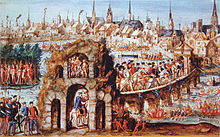Tupinambá people
[7] The Tupinambás were abundantly described in André Thevet's 1572 Cosmographie universelle (English: The New Found World, or Antarctike), in Jean de Léry's Histoire d'un voyage faict en la terre du Brésil (English: History of a Voyage to the Land of Brazil) (1578), and Hans Staden's Warhaftige Historia und beschreibung eyner Landtschafft der Wilden Nacketen (English: True History: An Account of Cannibal Captivity in Brazil, lit.Thevet and Léry were an inspiration for Montaigne's famous essay Of Cannibals,[8][9] and influenced the creation of the myth of the "noble savage" during the Enlightenment.In May 2023, the Brazilian House of Representatives approved the Marco Temporal project, which limits the demarcation of indigenous lands.[17] It states that indigenous peoples only have claim to the land they occupied during the 1988 Constitution promulgation, meaning they can be removed from where they reside now if they cannot prove they permanently lived there in 1988.[21] With the land demarcation movement in progress, the Tupinambá were able to exert their constitutional right to differentiated indigenous education.It promotes social interactions between indigenous and non-indigenous, in an effort to maintain Tupinambá identity and fight intolerance.
France AntarctiqueHenry II of FranceTabajaraPortuguese colonialTupi-speakingTupiniquimPotiguaraCaetéPortugueseEastern Atlantic coast of BrazilSão Francisco RiverRecôncavo BaianoCabo de São ToméRio de JaneiroSão SebastiãoSão PauloNheengatuOlivençaAndré ThevetThe New Found World, or AntarctikeJean de LéryHistory of a Voyage to the Land of BrazilHans StadencannibalismMontaigneOf Cannibalsnoble savageEnlightenmentslash-and-burnAtlantic ForestIlhéusTapajósBrazilian governmentBrazilian House of RepresentativesMarco TemporalBrazilian Supreme Federal CourtPresident LulaBrazilian ConstitutionwoodcutcannibalisticLouis XIIIClaude d'AbbevilleCatarina ParaguaçuDiogo Álvares CorreiaTearful salutationsCannibalism in the AmericasNavarro, Eduardo de AlmeidaMeade, Teresa A.EssaisTV GloboFolha de S.PauloBrasíliaMinistério da EducaçãoHistory of a Voyage to the Land of Brazil, Otherwise Called America